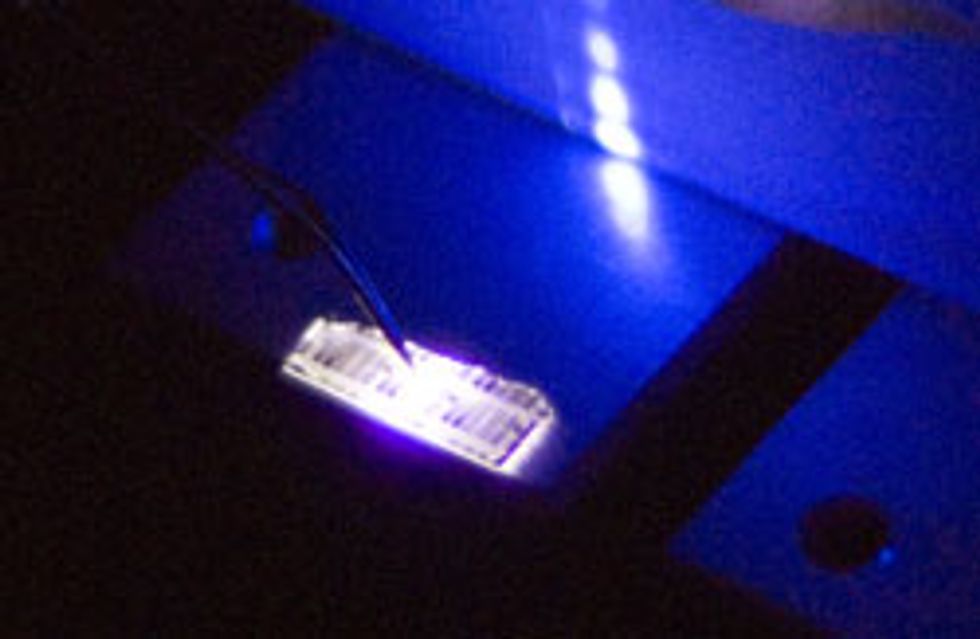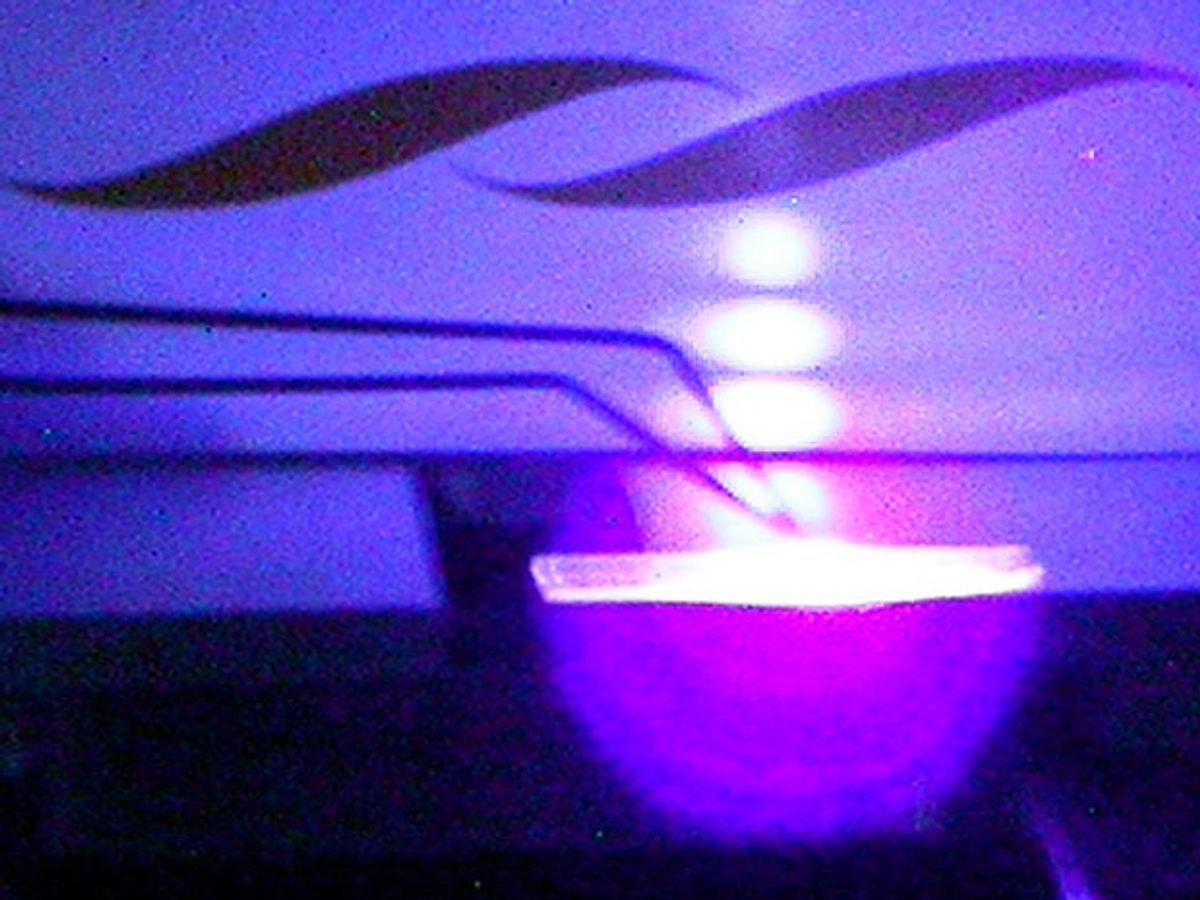
Researchers working in California and Japan have demonstrated a promising new gallium-nitride laser that emits bright blue-violet light and may eventually be coaxed to go green. The consumer electronics industry craves these colors, because they can pack lots of data into smaller areas and be combined with other sources to create full-color displays.
First off the mark on 27 January was a group led by Shuji Nakamura, Steven P. DenBaars, and James S. Speck at the University of California at Santa Barbara. (Nakamura is famous for inventing the blue-emitting GaN diode in 1992 and the blue GaN laser in 1996—achievements for which he was awarded the 2006 Millennium Technology Prize.)
UCSB Chancellor Henry Yang recalls getting a phone call that rainy Saturday afternoon urging him to hurry down to the laboratory in the university’s Solid State Lighting and Display Center. There he was greeted by a demonstration of bright blue-violet laser light emanating from a tiny pinprick of semiconductor material. At a press conference on 20 February, he exclaimed that the discovery would lead to ”a revolution in this technology.”
This laser differs from all previous GaN laser diodes in the nature and orientation of its crystalline structure. Most conventional GaN lasers begin life on top of a substrate of sapphire; workers then lay down successive layers of GaN and its various alloys using a technique called epitaxy. Because of the way the substrate is oriented, the diode structure grows along the hexagonal c -plane.
Unfortunately, strong polarization fields occur along this plane, and together with related piezoelectric effects, they act to separate electrons from holes—quasiparticles representing the absence of electrons in the crystalline structure. This segregation hinders the ability of the electrons to recombine with the holes to produce light. The effect becomes especially severe as the emitted wavelength or color shifts from violet to blue to green; this is the main reason that green GaN lasers have remained a distant dream for over a decade.
The new approach begins not with sapphire, but with a GaN substrate—one, however, whose crystal is oriented along the m -plane rather than the usual c -plane. These ”nonpolar” laser diode structures grown on m -plane substrates have much lower polarization fields and piezoelectric effects in their active layers, and as a result, electrons and holes recombine there more efficiently. Tokyo-based Mitsubishi Chemical Corp., a partner in the UCSB Center, supplied the GaN substrates to both the U.S. and Japanese research groups.
Not only does the m -plane orientation avoid the unwanted electric fields, but these substrates also come with fewer dislocations and other defects. And because their material is GaN rather than sapphire, its crystal structure matches that of the built-up diode much better, avoiding defects at the interface between the two dissimilar materials.
The initial UCSB devices were fabricated in January and reported on 23 February in the Japanese Journal of Applied Physics . These early units began to lase at a current density—that is, the current per unit of cross-sectional area—as low as 7.5 kiloamperes per square centimeter, about five times as high as that of commercially available blue lasers, made by Sony and others. But by the time of the press conference some three weeks later, the researchers had already cut this value in half.
Although those first lasers operated in pulsed mode, continuous-wave operation should not be difficult, says Mathew Schmidt, the graduate student who did much of the UCSB lab work. He noted that by late February, the group had already raised the duty cycle of its lasers to 40 percent—which means that the activation pulse was ”on” two-fifths of the time. Both achievements augur well for a rapid commercial adoption of the nonpolar, m -plane approach.
Meanwhile, in Japan...
In the same journal issue, researchers at Rohm Co., in Kyoto—another partner in the UCSB Center—published a paper stating that they had fashioned a similar blue-violet laser in early February using a similar approach. According to the paper, their laser operated in the preferred, continuous-wave mode, at current densities as low as 4.0 kA/cm2. (In fact, Hiroaki Ohta of the Rohm group said his team had achieved lasing even earlier than that, but this claim could not be confirmed at press time.)
These two rapid-fire successes make it clear that the availability of high-quality GaN substrates was crucial to the breakthrough. So commercialization of the new lasers will depend on getting enough good material. Mitsubishi indicates that right now it has only enough capacity to satisfy the research needs of its partners in the center. But the company will probably try to ramp up its production of m -plane substrates—as will others, such as Kyma Technologies in Raleigh, N.C., which specializes in GaN substrates.
The cost of the substrates, however, remains a major concern. Kyma’s chief technical officer, Drew Hanser, citing his company’s earlier experiences with c -plane GaN substrates, estimates that the first 2-inch wafers of m -plane GaN substrates will cost more than US $10 000 apiece. Compare that with the $20 to $30 that laser and LED makers now pay for comparable-size wafers of c -plane sapphire, according to a report from Strategies Unlimited, a Mountain View, Calif., market research firm. So even though laser-diode production yields may be 10 times better than on sapphire, the cost of GaN substrates will still have to come down by an order of magnitude for this approach to be competitive.
UCSB’s DenBaars estimates that it will take manufacturers two to three years to resolve all the production problems and bring the new GaN lasers to market. When that happens, the units could begin to replace the blue-violet lasers currently used in Sony’s Blu-ray and competing high-definition DVD players, which boast 27 gigabytes of storage capacity—enough to hold five feature-length movies. According to DenBaars, the GaN lasers in these units now account for 20 to 30 percent of the product’s retail price of about $600.
Nonpolar lasers have another advantage in that their light is naturally polarized. This makes them ideal for use in compact liquid-crystal displays, which require polarized light.
Target: green light
The real payoff should come in producing green laser light—something no semiconductor laser has done in the 45 years since these devices were invented—according to Noble Johnson, an IEEE Fellow and a laser scientist at Xerox’s Palo Alto Research Center, in California. Electron-hole segregation and related effects in polar c -plane diodes cause quantum efficiencies to plummet rapidly toward zero at green wavelengths of 550 nanometers, says Nakamura. But nonpolar GaN diodes lose only a few percent in efficiency in this range, because many more electrons and holes are able to recombine. The new approach may allow for much brighter green LEDs, Johnson says, but it will prove more difficult getting similar nonpolar diodes to lase at these wavelengths. Rohm is taking dead aim at this target, however, and others will certainly follow suit. In early February the company claimed its researchers were working on a green GaN laser that should operate at 532 nm by year-end, a timetable that Johnson thinks is optimistic.
Once someone makes a green solid-state laser diode at an acceptable cost, it will be possible to combine it with existing red and blue laser diodes in several exciting new applications for consumer electronics. Rohm predicts that they will be used in large-screen, HDTV screens with a color range more than 50 percent better than current analog television standards. Even miniature, laser-driven pocket projectors may become possible. And who knows, they may also end up in cellphones, the way everything else electronic has.
About the Author
Contributing Editor Michael Riordan teaches the history of physics and technology at Stanford and the University of California, Santa Cruz.
